Make this easy, melt-in-your-mouth Chashu pork belly recipe at home! Braised in a sweet and savory sauce, these tender slices of meat can now top your next bowl of ramen! It’s the most fulfilling reward for any pork belly lover out there!
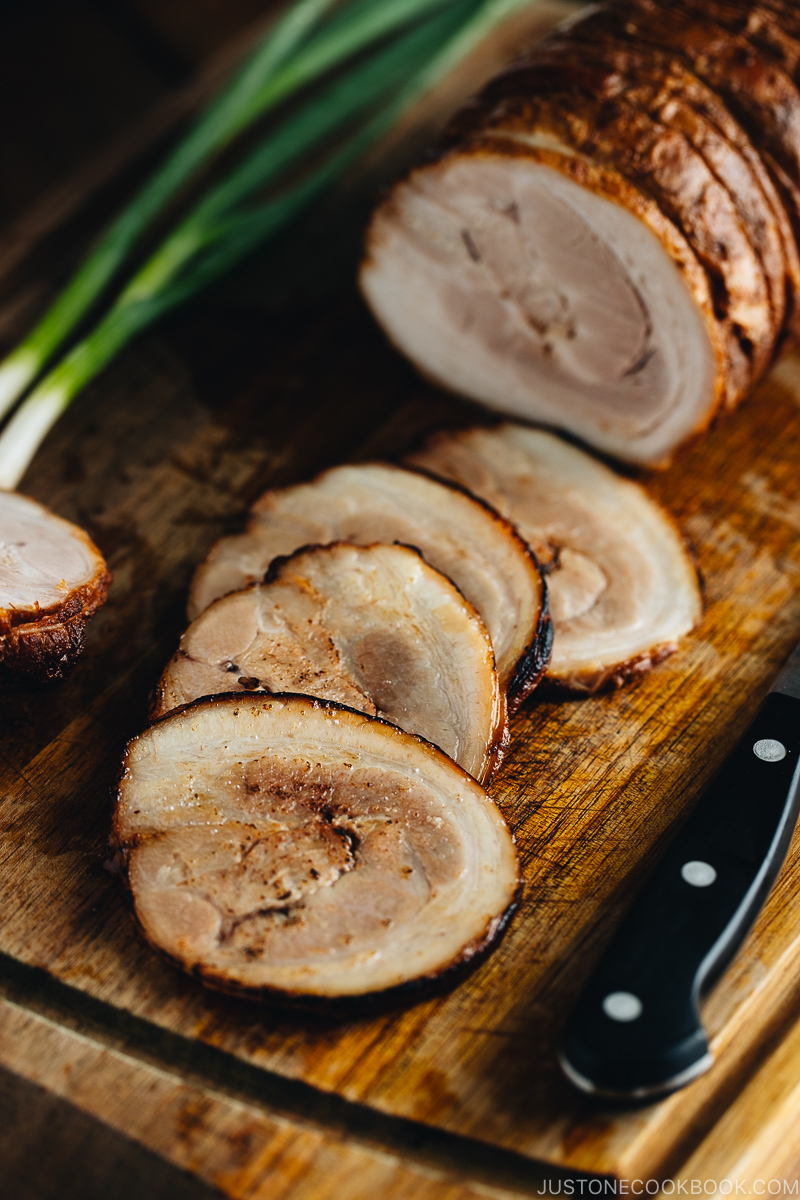
What is your favorite ramen topping? For me, it is the perfectly cooked soft-boiled marinated Ramen Egg (Ajitsuke Tamago). But for most people I know, including Mr. JOC, it is the melt-in-your-mouth juicy, tender, and flavorful slices of braised pork belly known as Chashu (チャーシュー).
What is Chashu?
Japanese have adapted the famous Chinese barbecued pork called Char Siu (叉燒) as chāshū (チャーシュー). Unlike the Chinese version which requires roasting over high heat, we prepare the meat by rolling it into a log and then braising it over low heat in a sauce seasoned with soy sauce, sake, and sugar.
In Japanese, we sometimes call Chashu “Nibuta” (煮豚), literally means simmered/braised pork, as opposed to “Yakibuta” (焼豚), which means barbecued pork. The Japanese enjoy Chashu as a topping for Ramen and other noodles, as well as Chashu over steamed rice called Chashu Don, like a rice bowl.
The Original Chinese Char Siu
Traditionally, Chinese char siu is marinated in soy sauce, honey, hoisin sauce, rice wine, five-spice powder, and red food coloring, and then roasted in a covered oven or barbecued over a fire. You have probably seen the slabs of barbecued pork hanging in Chinese deli shop windows.
Chinese Char Siu offers a good bite with marked, smoky grilled flavor, while Japanese chashu is appreciated for its succulent and fork-tender texture.
Watch How to Make Chashu
Make this easy, melt-in-your-mouth Chashu pork belly recipe at home! Braised in a sweet and savory sauce, you can now add the tender slice of meat as topping to your next bowl of ramen. It’s the most fulfilling reward for any pork belly lover out there!
A Quick Rundown on How to Make Chashu Pork
First, we sear the pork belly over high heat to caramelize the surface of the meat. My go-to choice is a solid cast iron pan which I use for searing meats. With a cast iron, you can really turn up the heat and food comes in direct contact with an evenly heated surface. This step makes a great difference with the finished dish, enhancing it with complex layers of flavors.
After searing the meat, we then braise the meat in a soy sauce based seasoning on a simmering low heat for about 1-2 hours. The pork will slowly soak up all the flavors in the pot. Ginger and long green onion (in Japan it goes by a few names – Naganegi (長ねぎ), Shironegi (白ねぎ) or Tokyo negi (東京ねぎ)) help remove any unsavory smell and add more depth to the sauce.
When the sauce reduces, transfer the meat to a bag or a container with a little bit of sauce, and let marinate in the refrigerator overnight to intensify the flavors.
Next day it’s finally ready to serve. Slice the Chashu thinly but thick enough for the chopsticks to clasp on.

Chashu 2 Ways: Rolled (Log) vs. Non-Rolled (Block)
Chashu served on ramen is often the rolled type, although many ramen shops do serve slices of the Non-Rolled Chashu in Japan. Both ways are legitimate Chashu by the standard of ramen shops, but let’s take a look at the two options.

Rolled Chashu (Log)
The most common preparation for Chashu served on ramen is by rolling a big slab of pork belly into a log with butcher’s twine. The main reason for that is to keep the pork moist. As the meat is not directly exposed to the sauce, meat does not get dry yet it still absorbs flavors.
When I roll the pork belly into a log shape, I usually increase the amount of cooking time because you will need more time to rotate the Chashu and to make sure it soaks up all the good flavors.
You may wonder why I don’t increase the amount of seasoning so that Chashu will be completely submerged. Ramen shops make Chashu every day and they keep re-using the cooking sauce by combining with a new batch of seasoning. To a home cook, it is rather wasteful to make such a big batch of cooking sauce.
That’s why you will need 2 hours to cook Rolled Chashu (as opposed to 1 hour for Non-rolled Chashu).

Non-Rolled Chashu (Block)
If you don’t need a lot of Chashu, consider making Non-Rolled Chashu with smaller blocks of pork belly. The pork belly blocks I buy from the local Japanese supermarket come in small pieces (¾ to 1 lb). Since you don’t need to roll them up into a log, you can start searing the pork belly right away.
The benefit of Non-Rolled Chashu is that braising time takes just 1 hour as the slab of pork belly is fairly flat and easily absorbs flavors. Make sure to use Otoshibuta (drop lid) so that the sauce circulates nicely and won‘t evaporate too much evaporation braising.
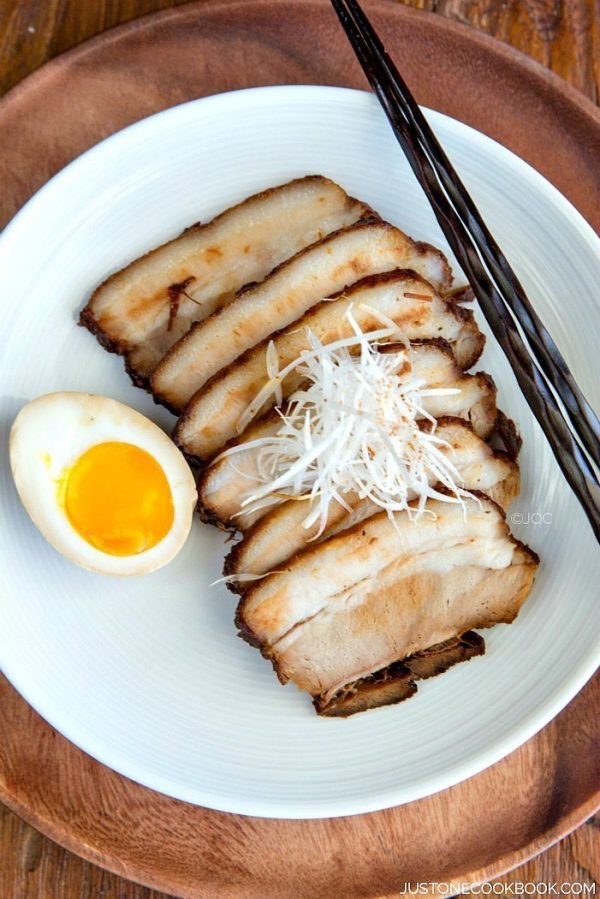
Chashu (Non-Rolled Chashu) served with Shiraga Negi topping and Ramen Egg.
How to Roll and Tie Chashu
Why do we roll Chashu?
- To maintain the shape after rendering fat.
- To keep the moisture in the meat (protected by outer layer/rind).
- To look pretty

Learn how to roll and tie pork belly correctly
You can find the step-by-step pictures in the recipe below and the video above to go over the step, but here’s the quick summary.
- Find out the right orientation for rolling. One or both ends should have the “bacon” like appearance, showing the varying layers of meat and fat.
- Roll up and find how much pork belly you need for a nice cooking Chashu. Cut off any extra meat and save it for other recipes.
- Once you roll up the pork belly into a log, wrap the meat with a butcher twine on one end and make a double knot.
- Wrap 2-3 more times on the same end (the starting point) to make sure it is secured.
- Then run the twine across the log to the far end and wrap 2-3 times tightly. Both ends are now secured.
- From this end, start wrapping tightly and work toward the starting point, keeping ⅓ inches (1 cm) between each wrap.
- Once you reach the starting point, run the twine under some wraps around the middle and then bring back to the starting point.
- Make a double knot with two ends of the butcher twine.
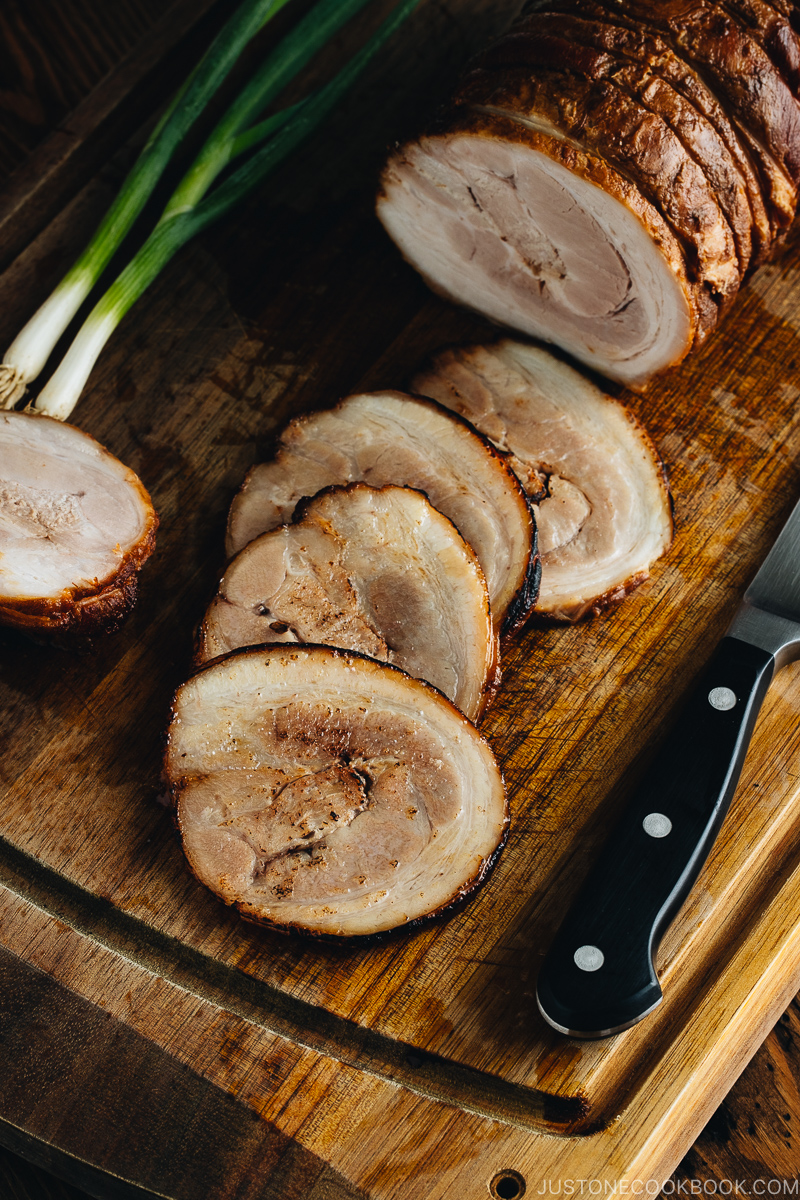
What Cut of Pork Do We Use for Chashu?
The ideal cut for chashu is pork belly, although you can use pork shoulder, and sometimes pork loin. Keep in mind that the last two choices don’t get the melt-in-your-mouth texture as they do not have as much fat as pork belly.
In Japanese cooking, we usually use pork belly without a rind/skin (except for making certain Chinese or Okinawan recipes).
I always use pork belly for my Chashu recipe, but if you try pork shoulder, let me know. I personally would not recommend using pork loin for this recipe.

Where to Buy Pork Belly
You may not find pork belly sitting at the butcher window or sold pre-packaged, but most butchers should have them stored in the freezer. So don’t be shy to ask the butcher at your local grocery stores or meat deli. Ready to make pork belly on the same day? Do call ahead and factor in the defrosting time as they usually come frozen.
The best place to shop for pork belly is Korean grocery stores. They sell different thicknesses and sizes of pork belly. I usually request the butcher to cut a specific size just for me.
You can also ask the butcher to remove the rind/skin (if there is any) or remove it yourself using a sharp knife.

How to Cut Chashu
It’s pretty easy to cut the Chashu into thin slices once it has rested in the refrigerator overnight. A sharp bread knife would make your job relatively easier too.
I don’t usually use up the entire Chashu in one meal, so I’d cut it into several thin slices for Ramen, and then cut the rest into 2 to 3 blocks and pack each piece in the Food Savor bag to store in the freezer. I’ll show you below how I use Chashu besides Ramen.
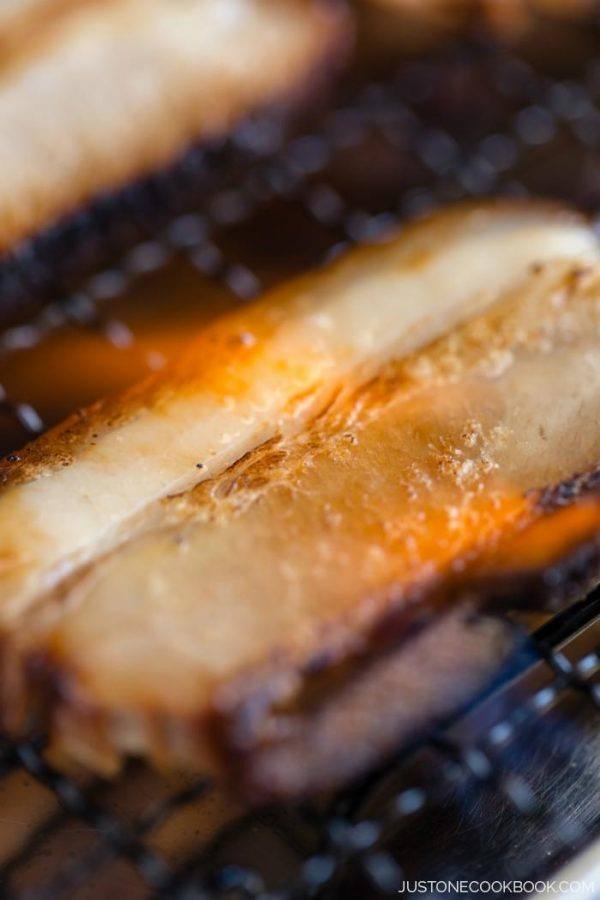
How to Reheat Chashu
There are 3 ways to reheat Chashu:
- Soak Chashu in the hot cooking sauce.
- Directly put in the hot noodle soup.
- Sear the Chashu using a culinary butane torch. We call this Aburi Chashu (炙りチャーシュー). Aburi means searing in Japanese and you may have heard about Aburi Toro and Aburi Salmon from the sushi menu.
I use searing options to reheat Chashu and to add smoky charred flavor. Don’t forget to drizzle some hot cooking liquid on top!
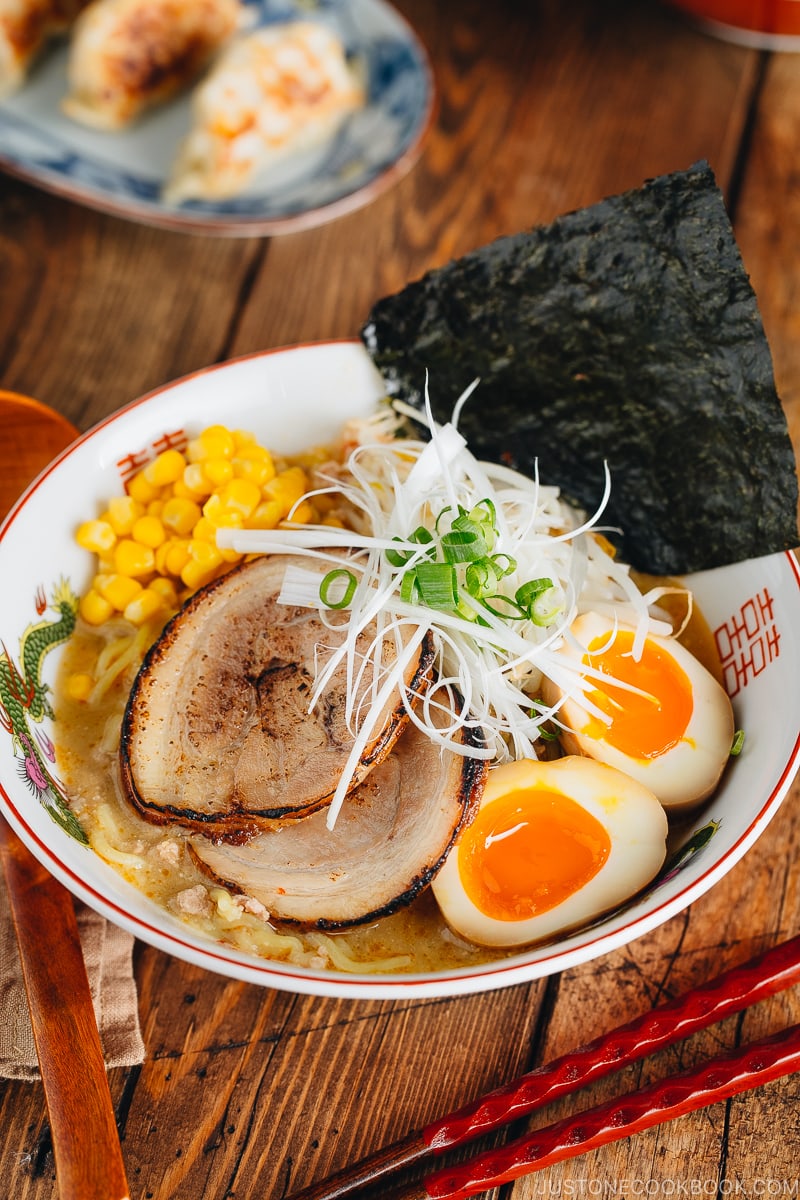
Various Ways to Enjoy Chashu
Besides enjoying Chashu with ramen or by itself, you can also use it for many other dishes. Here are my suggestions:
- Noodle dishes – Hiyashi Chuka and Tsukemen
- Rice dishes – Chashu Don (over rice) and Chashu Fried Rice – a great way to use up the broken pieces or edges of Chashu.
- Sandwiches – Serve with steamed buns (use this recipe)

What to Do with Leftover Chashu Cooking Sauce
- Stir fry seasoning
- Marinate for grilling meat
- Make Ramen Egg

Family’s Favorite Recipe for a Long Time!
I’ve been cooking this exact Chashu recipe for almost 20 years (and on the blog since 2011) and my family loves it. It’s not that difficult to make at all, but you may need to be around in the kitchen while simmering the meat. The final reward is phenomenal and it’s totally worth your time!

Wish to learn more about Japanese cooking? Sign up for our free newsletter to receive cooking tips & recipe updates! And stay in touch with me on Facebook, Pinterest, YouTube, and Instagram.

Chashu (Japanese Braised Pork Belly)
Video
Ingredients
For a Rolled Chashu Log (serves 8–10)
- 1 pork belly block (2–2½ lb, 907–1134 g; roughly 8 x 9 inches, 20 x 23 cm each; remove the rind from your pork belly)
- 1 Tokyo negi (naga negi; long green onion) (green part only; substitute with 1 leek or 2–3 green onions)
- 4 slices ginger
- 1 Tbsp neutral oil (for searing)
- 1 cup sake
- 1 cup soy sauce
- 2 cups water
- ⅔ cup sugar
For a Non-Rolled Chashu Block (serves 3; this is my original recipe posted on May 2011)
- ½ Tbsp neutral oil (for searing)
- ¾ lb pork belly block (for 1 lb (454 g) of meat, see Notes)
- 1 Tokyo negi (naga negi; long green onion) (green part only; substitute with 1 leek or 2–3 green onions)
- 4 slices ginger (from 1-inch, 2.5-cm knob)
- ⅓ cup sake
- ⅓ cup soy sauce
- ⅔ cup water
- 3 Tbsp sugar
Instructions
FOR ROLLED CHASHU (Scroll down for the NON-ROLLED version)
- Before You Start: Please note that this rolled Chashu recipe requires an overnight resting time of 8 hours.
DAY 1
- Gather all the ingredients.

To Prepare the Pork Belly
- Roll up your 1 block of pork belly (2–2½ lb or 907–1134 g). Make sure one or both ends have a “bacon-like“ appearance, showing the varying layers of meat and fat. If your slab comes with the rind, remove it or ask your butcher to do it for you.

- Run some butcher twine under the far end of the log. Tie a double knot to secure the rolled end tightly. Make sure you leave a tail of about 3 inches (7.5 cm) of twine at the end.

- Next, tightly wrap the twine around the spot you just tied another 2 or 3 times to secure the starting point of the roll. Then, pull the twine to the opposite end of the pork belly roll. Tightly wrap the twine around that end 2 to 3 times to secure it.

- Next, start wrapping the twine around the roll back toward the starting point. Space each wrap ⅓ inch (1 cm) apart. Make sure you wrap the roll as tightly as possible.

- Once you reach the starting point, run the twine under some of the end wraps; this hooks the twine in place so you can reverse direction. Next, run the twine under 4 or 5 wraps going away from the starting point. Then, double back toward the starting point, running your twine under the wraps until you reach the original double knot.

- Find the 3-inch tail of twine that you left when you started. Tie a double knot with the tail and the long end of the twine, and cut the excess.

To Cut the Aromatics
- Cut the green part of 1 Tokyo negi (naga negi; long green onion) and set aside; reserve the white part for another use. Cut 4 slices ginger (unpeeled).

To Sear the Pork Belly
- Heat 1 Tbsp neutral oil in a cast-iron skillet (or regular frying pan) over high heat. Add the tied pork belly to the skillet.

- Sear the pork belly one side at a time, rotating it to make sure all sides are golden brown.

- It’ll take about 10–15 minutes all together.

To Prepare the Braising Liquid
- While the pork is searing, prepare the braising liquid. Put 1 cup sake, 1 cup soy sauce, 2 cups water, and ⅔ cup sugar in a heavy-bottomed pot (I used a Dutch oven) that will fit the chashu. Then, add the Tokyo negi (green part) and 4 slices ginger.

To Simmer the Chashu
- Transfer the seared chashu roll to the Dutch oven.

- Bring the liquid to a boil over medium heat.

- Once boiling, skim off the foam and scum. Then turn the heat to low/simmer.

- Put an otoshibuta (drop lid) on top to press the ingredients down and limit the evaporation. You do not need to use a regular lid to control the evaporation. If you don’t have an otoshibuta, you can make one with aluminum foil (here’s how to make the otoshibuta).

- Simmer on low heat, and cover with the otoshibuta at all times for the next 2 hours, turning the chashu every 30 minutes.

- After 2 hours, the braising liquid has reduced a bit. Turn off the heat to let the chashu roll cool a little bit.

To Rest the Chashu Overnight
- Once the meat is slightly cooled, transfer it to a container or a plastic food vacuum-sealing bag, such as one for the FoodSaver system. (If you‘re doubling or tripling this recipe, put each chashu roll in its own bag.) Strain the leftover cooking liquid through a fine-mesh strainer.

- Add ½ cup of the cooking liquid into the bag. If using a container, add about 1 inch (2.5 cm) of the braising liquid to the bottom and cover.

- If using the FoodSaver bag, seal it with a FoodSaver sealer. Tip: Fold a piece of paper towel to plug the entry of the FoodSaver bag. This paper towel will absorb any extra moisture when you seal.

- Tip: I also made quick Ramen Eggs (Ajitsuke Tamago) with the leftover liquid. Simply cook and peel soft-boiled eggs, add them to a bag with ½ cup of the cooking liquid, and close. Cover the cooking liquid, and store the chashu, ramen eggs, and the cooking liquid in the refrigerator.

DAY 2
- Open the bag of chashu.

- Cut the twine with kitchen shears and remove the twine pieces completely.

- Slice the chashu into ¼-inch pieces and keep the end piece for Chashu Fried Rice!

- Place the chashu slices on a ceramic plate. Sear and enhance the flavor with a kitchen butane torch. You can also use a broiler in the oven. Enjoy them immediately or serve on your ramen.

- Scoop up and discard the solidified fat from the cooking sauce.

- Strain the sauce over a fine-mesh sieve to make sure the solidified fat is left behind. Pour the sauce into a mason jar or container and seal. The sauce will last for a month in the refrigerator. I use it for drizzling over the chashu and for making stir-fried dishes, marinades, and ramen eggs.

To Store
- You can store the chashu in the refrigerator for up to 7 days or 1 month in the freezer. I usually divide the rolled chashu into thirds and freeze 2 portions separately (for ramen right away, and Chashu Fried Rice and Chashu Bowl for later). Ramen Eggs should be consumed in 3–4 days if they are soft-boiled eggs and 7 days if hard-boiled eggs. The eggs get saltier the longer you keep them in the marinade, so remove them from the sauce when they have the right taste.
FOR NON-ROLLED CHASHU
- Gather all the ingredients. For small blocks of pork belly (about 1 lb) like I‘ve used here, you don’t need to roll them up before cooking, and the simmering time is just 1 hour (instead of 2 hours). Tip: To cook 1 lb (454 g) of pork belly, see the ingredients list in the Notes section at the end of the recipe card.

- Heat a cast iron skillet (or regular frying pan) over high heat. When the pan is hot, add ½ Tbsp neutral oil. Sear ¾ lb pork belly block fat-side down first, then flip over to sear the other side; this will take about 10 minutes.

- While searing, prepare a heavy-bottomed pot (or regular pot) that will fit the chashu. To the pot, add the green part of 1 Tokyo negi (naga negi; long green onion), 4 slices ginger (unpeeled), ⅓ cup sake, ⅓ cup soy sauce, ⅔ cup water, and 3 Tbsp sugar. Once you‘re done searing the meat, add it to the pot. Bring the liquid to a boil, skimming the scum and foam. Then, turn the heat to low/simmer.

- Put an otoshibuta (drop lid) on top to press the ingredients down and limit the evaporation. If you don’t have an otoshibuta, you can make one with aluminum foil (here’s how to make otoshibuta). Simmer on low heat for 1 hour, turning the chashu every 15 minutes and keeping an otoshibuta on at all times.

- After 1 hour, there is ½ inch of liquid left in the pot. Now, you have 2 options. Option 1: If you’re serving it right away, remove the otoshibuta and further reduce the sauce on low heat until the sauce thickens and you can see the bottom of the pot when you draw a line through the sauce with a spatula. Option 2 (recommended): Transfer the chashu to a container or bag with a little bit of cooking sauce and refrigerate overnight. Strain the leftover cooking sauce, transfer to a jar, and refrigerate.

- To serve, slice the chashu into ¼-inch (6 mm) pieces. Sear and enhance the flavor with a kitchen butane torch. If you stored the chashu overnight and don’t want to sear the chashu, you can reheat it by soaking it in hot cooking sauce.

Notes
- 1 lb pork belly block (454 g)
- 1 negi (long green onion) (substitute with 1 leek or 2-3 green onions)
- 1 knob ginger
- ½ Tbsp neutral-flavored oil (vegetable, canola, etc.)
- ½ cup sake (120 ml)
- ½ cup soy sauce (120 ml)
- 1 cup water (240 ml)
- ⅓ cup sugar (75 g, 5 Tbsp)
Nutrition
Editor’s Notes: This post was originally shared in May 2011. The first video was added in September 2014 with new images. New video and images are added in May 2019.





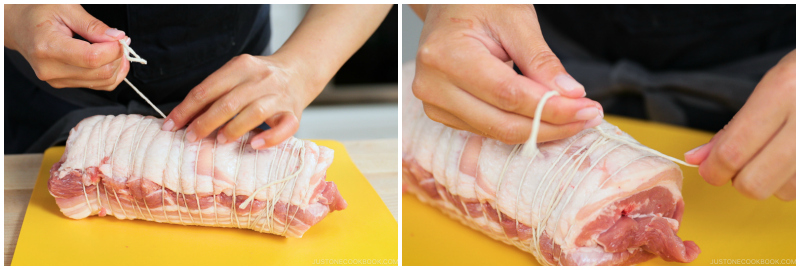








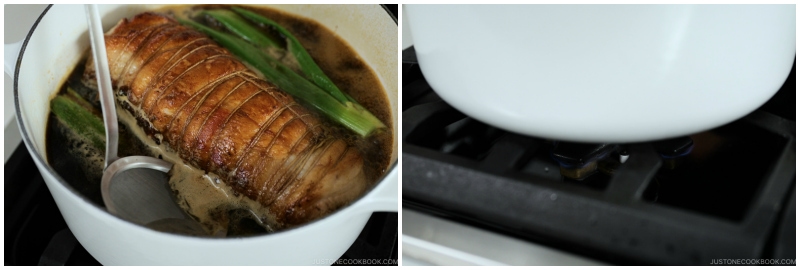


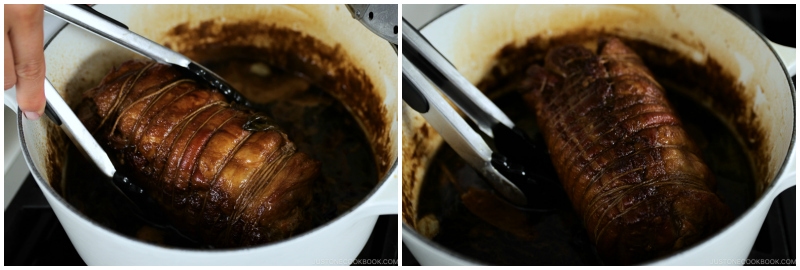













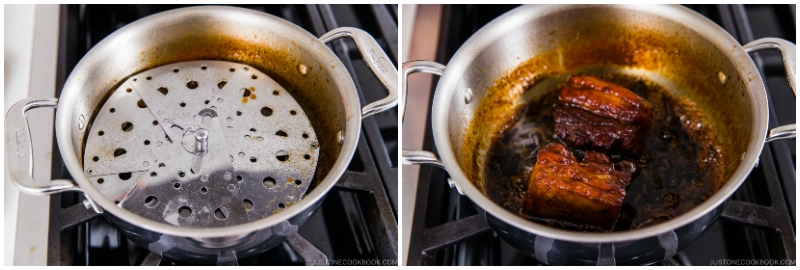
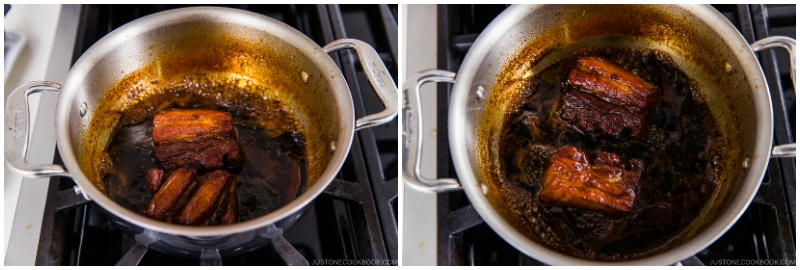
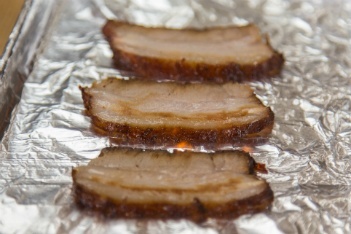












Hello Nami,
first of all thank you very much for this detailed recipe! I lived in Japan for one year and Sapporo Miso-Ramen became my favourite dish there. Sadly I could no find any Ramen Restaurants here in Germany – at least near me – so now I am very happy to have found your website and his recipe on it 🙂
But now here is my problem. My girlfriend is strictly opposed to alcohol (even if the heat reduces it by cooking for a long time). Is there any way to substitute the sake (in your Chashu recipe) and the Mirin (in the Ramen egg Recipe) which still creates a similar flavour?
Thank you!
Ps.: Can’t wait to try your kare risu next 🙂
Hi Stefan! Thank you so much for your kind comment. I hope my ramen recipe will be something similar to what you had in Hokkaido…but frankly, many hours or days vs my 20 minute broth may not be comparison, but I hope you get to cook more frequently because it’s easy and delicious! 🙂
Don’t worry – you can skip sake… result may be a bit different because sake is important to remove the unnecessary smell from the pork and tender meat etc… but it should not give a big impact at the end. And for ramen egg, yes you can omit mirin, but make sure to add enough sugar so it adds some sweetness to it, not just salty soy sauce flavor. Hope this helps!
Kare Raisu! Yay, that’s a good one. 😀 Hope you enjoy!
It is wonderfull . Thank you for your pin.
Thank you for checking this post, Jungwoo! 🙂
Dear Nami,
Did you use Pork Belly with Skin or Pork Belly without Skin. Which better to use in this recipe. Thank you!
Hi Steve! Mine comes without skin. If yours come with skin, I have a video in Note section that might help you remove the skin. 🙂
Dear Nami,
I am in luck. The two pieces that I bought last month are skinless and virtually fat free. I making the one that weighs 34 ounces. It is already thawing in the fridge.
(P.S. I did not like the recipe for Chinese Pork Belly that I used last time. So your recipe is like something delivered from heaven…)
Great! I think having fat is necessary for moist and tender chashu though. I hope your “fat-free” pieces will come out juicy and tender. Good luck!! 🙂
Oh my! I think my family (hubby) would just gobble up the chashu and it wouldn’t make it to the ramen!
Thank you for sharing this recipe!
Hi Donna! Haha it’s highly possible. I usually make two blocks together so that I can save one for ramen and one for by itself and chashu fried rice. Thank you for checking this post! 🙂 xo
Could you please explain the difference between pork belly kakuni and chashu. They would appear to be the same although chashu is often rolled up. Thank you for your excellent work in helping us enjoy and understand Japanese cuisine.
Hi Constantine! You have a good question! The cooking method for homemade quick chashu is sort of similar to one for Kakuni. Some home and restaurant ramen includes “Simmered Chashu (煮豚チャーシュー)” and mine is the same. So “simmered chashu” is more like a short cut version. 😉
Thank you again, very very useful information. My family is so happy when they see me on your website looking for something to cook. great Chashu recipe. Thank you again
Hi Les! Haha thank you so much for checking my website! I hope you enjoy my recipes. 🙂
Nami – I made this yesterday and I love the flavour of the chashu!
But I found my meat a little too tough as compared to chashu from ramen restaurants.. I was cooking the meat under the otoshibuta for about half hour till the sauce thickened. Any advice on how I can make the meat more tender?
Hi Alana! This is a very quick method and hard to compare with the softness of meat when it’s cooked for hours. However, I’ll try to find a way to make it better. 🙂 I’ve been meaning to make different version, but have been busy with other recipes…
Hi, just want to let you know that I really like this recipe. The chashu tasted great and so easy to make! The best part is, I used the leftover several times to make more ramen, fried rice and steamed rice, and they all taste much better with chashu in it. Flavor was still delicious after frozen.
Looking forward to more delicious recipes. 🙂
Hi Maggie! I’m very happy to hear you liked the recipe. I especially love to put the leftover in fried rice too. So good! I sometimes think I look forward to fired rice more than eating with ramen. Thank you for trying the recipe and writing feedback. xoxo 🙂
Hi Nami, my first time visit your blog, I googled California rolls and saw a very details instructions including pictures on your blog, I really like it,
thank you for a very nice and descriptive recipe,
Hi Ta! Welcome to my blog! So happy that you stopped by and enjoyed my site. Thank you so much for writing!
Nami, thanks for this wonderful recipe. I lived in Japan for two years a couple years ago and I was starting to crave chashu and this was delicious. My wife who doesn’t usually like beef or pork loved it and I wished I would have made more. Thanks! -Matt
Hi Matt! Thank you so much for your feedback! I’m so happy you and your wife enjoyed this recipe. Next year I’m planning to improve my chashu recipe. This recipe is very easy, but I really want to make it even softer… Thank you again for writing! 🙂
I don’t know if you check this but my boyfriend took a stab at making shio ramen for me tonight. I told him I wanted meat (chashu) in it but that I didn’t know how it was made. I looked up some recipes and yours looked the most aesthetically pleasing (^-^) and he was like ok, I’ll make it (mind you he’s American, never lived in Japan (I did for 5 years that’s why I was asking him to make ramen) and that’s what he did. うまかったよ!本当に! It was so delicious….I wished that I had some white rice to just eat the chashu (he put daikon, ginger, garlic, some other stuff I’m not even sure but it was GOOOD!). Yep, this was the first time he had Japanese ramen, first time tasting chashu and he even said he would use the sauce in other dishes. Thank you thank you for such a lovely recipe! ごちそうさまでした!
Hi iLaShonda!
Thank you so much for your feedback! I’m so happy to hear that you and your BF enjoyed homemade chashu! 🙂 Ramen shop takes a long time to make chashu, but this recipe is pretty good for the amount of time you spend to cook. It’s easy and delicious. メッセージどうもありがとう!とても嬉しかったです!
Hey Nami,
Can I subsitute cooking sake with Chinese Rice Cooking Wine? At this rate I am subsituting: Konbucha, Tokyo Negi and then sake.
Also, I read your first comment about your children enjoying Pho. I should be getting a Pho recipe from one of my Vietnamese friends, want me to pass it to you when I get it?
Thanks,
P
Hi Patrick! Yes you can use that. 🙂
The Pho recipe sounds nice! Yes, if it’s not troublesome, would you email me with the recipe? Thank you Patrick!
Nami,
For the Tokyo Negi, can I substitute is with green onions? as it is easy available.
BTW, I gave your teba shio recipe a try, I loved it! Thanks for posting such a great recipe. I kinda set my oven on fire from the wings’ grease.
Hi Sandrine, I’m sorry I shouldn’t have laughed but when you said you set your oven on fire I just imagined the scene of chaos and had to laugh… I hope everything was okay though and I’m sorry I should have mentioned that everyone must be careful when broiling. I’m glad you liked the recipe. Wasn’t it easy? 😉
As for the Tokyo Negi, yes you can substitute with green onions. 🙂 Hope you will like it!
Nami!
I was looking for Chshu ramen recipes and came across your website!
You have such nice pictures and good layout and I love to read your looking steps! Really well, written simply and gentle (like a true Japanese lady Hehee).
I followed your steps in this chashu recipe and my meats came out really nice. Perhaps a little too salty coz I may have been too generous w the soy suace and salt. But the meat is tender n delicious! Thank you!
I also love your Otoshibuta foil method. Such a genius!
Will be checking out the rest of your recipes. You have a new FAN here! Keep up the good job!
Hi Cecilia! Thank you for stopping by my website. I’m happy you found my site and liked it. I’m glad step-by-step pictures are helping. I’ll keep working hard! Otoshibuta method is great, right? It’s genius invention I believe! I’m glad you became a fan and thank you so much for leaving the kind message here. I’m so happy~~~. 🙂
Really glad to find this website. I’m a guy and I enjoyed cooking on occasion. In this case, I’m interested in trying out your chashu recipe. I was curious, however, about cooking sake vs. mirin? I have a bottle of mirin at home and, if it’s an acceptable substitute for cooking sake, it’ll save me a trip to the Japanese grocery store. And, if I can use mirin, what amount would you recommend for this recipe? Thanks so much!
Hi Dennis! I’m so happy to hear you like my site! Thank you. 🙂 As for cooking sake vs. Mirin, they are completely different. Cooking sake or sake is pretty similar. I’m not a sake drinker, but you can buy a cheep small sake bottle and that works just fine too. Or you can use any kind of Asian cooking wine (Chinese rice wine etc). Mirin is sweet and we use it as substitute of sugar since Mirin has very mild sweetness. I hope you will like this recipe!
Nami,
I went to the local Japanese market and looked for konbucha. I didn’t realize that konbu-cha is basically seaweed tea until the lady working there pointed me to the tea section. I asked her if the konbucha that she showed was used for seasoning food and she said “no”. But the characters were as you described. Did I get the wrong thing? Thanks!
Hahaha! Thank you Dennis for writing. Yes you did buy the right kind! A lot of Japanese use Konbucha as seasonings because it has good Umami (use as salt). You are fine! 🙂 I can’t wait for you to make Chashu! I hope you will like it! Good luck.
Ah, I see now, upon reading the comments section more carefully, that you had already mentioned that konbucha might be in the tea section. To your credit, there are so many comments that I just missed it the first time. I will try recipe tonight…thanks for the good luck wishes, I’ll probably need it. 🙂
Hi Dennis! How did it go? I hope it came out okay. 🙂
Nami,
The chashu turned out pretty well, considering the fact that I’m not an especially good cook. The flavor was definitely a highlight…I’m not sure to what extent the flavor was due to konbucha (vs. regular salt), but my wife and I liked it a lot.
The hardest part, believe it or not, was finding a cut of pork belly that I liked. The Asian markets locally only had frozen pork belly in stock last weekend, so I actually purchased the meat at a Mexican meat market. In addition, the cut of pork belly that I go had that tough, outer skin on it that was very difficult to cut off. I decided to cook the meat first and try to remove it after it’d been cooked. Still, it was an extra hassle.
The drop lid worked pretty well, too, I think. Thanks for the great recipe, tips, and responses in the comments section!
Hi Dennis! I’m glad you liked it. Konbucha has konbu dashi which salt doesn’t have. We use konbu to make dashi too, so you can imagine some umami from konbu is added.
For Chashu, I always buy pork belly from Nijiya supermarket. The meat quality is pretty good there. I always buy meat from good store because you take time to cook so I really want the quality rather than quantity. I’m unfortunately unfamiliar with cut of the meat…but I saw nice pork berry in Lundardie’s (I think this is Bay Area only). This supermarket has everything that I can’t find in regular supermarket…so more of high end. but their pork belly was pretty beautiful. Does Mitsuwa have pork belly? I know they should have sliced pork belly…but not sure about block. Mine is very soft and it’s almost hard to cut (because the meat is tender). We didn’t waste any of the meat as my husband likes fat part too… Sorry the meat gives you a little hassle. Hope you can find a better meat somewhere. Drop lid is necessity in Japanese cooking. You only need a little bit of liquid yet it goes around to the top and cook so well without flipping too often. Thanks again for giving me feedback!
Can I challenge you to adapt this recipe to the Instant Pot? This meal seems like a perfect use for it but I’m stuck on what to set the pressure cook time at. I’ll give it a try tonight (unrolled) and see what I can do myself.
Hi Ross! I haven’t tried it so I’m not sure how long it will require to be the perfect texture. Keep us posted!